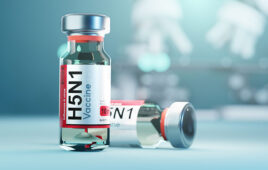
Data from the Phase 3 MMY3004 (CASTOR) clinical trial show the immunotherapy daratumumab (Darzalex) in combination with a standard of care therapy, bortezomib (a proteasome inhibitor [PI]) and dexamethasone (a corticosteroid), demonstrated a 61 percent reduction in the risk of disease progression or death (progression-free survival, or PFS) compared to bortezomib and dexamethasone alone in patients with multiple myeloma who received a median of two prior lines of therapy (Hazard Ratio (HR) = 0.39; 95 percent CI (0.28-0.53), p<0.0001).
According to results Janssen Research & Development, LLC announced today, daratumumab also significantly increased the overall response rate (ORR) [83 percent vs. 63 percent, p<0.0001]. The median PFS in the daratumumab arm has not been reached, compared with a median PFS of 7.16 months for patients who received bortezomib and dexamethasone alone.
These data will be presented in full today at 3:10 – 3:25 p.m. CDT during the “Plenary Session: Including the Science of Oncology Award and Lecture” at the 2016 American Society of Clinical Oncology (ASCO) Annual Meeting in Chicago. They have also been selected for inclusion in the ASCO Press Program.
“We saw clinically meaningful improvements in progression-free survival and overall response rates with daratumumab when combined with standard of care,” said Antonio Palumbo, M.D., Myeloma Unit Chief, Department of Oncology, Division of Hematology, University of Torino, Italy. “These compelling Phase 3 results demonstrate that a regimen built on daratumumab deepens clinical responses and help to underscore its potential for multiple myeloma patients who have been previously treated.”
In addition to meeting the primary endpoint of improved PFS at a median follow-up of 7.4 months and significantly increasing the ORR compared to bortezomib and dexamethasone alone, daratumumab doubled rates of complete response (CR) or better [19 percent vs. 9 percent, p<0.0012], including doubling rates of very good partial response (VGPR) [59 percent vs. 29 percent, p<0.0001]. The median PFS has not been reached, compared with a median PFS of 7.16 months for patients who received bortezomib and dexamethasone alone. The treatment benefit of the daratumumab combination regimen was maintained across clinically relevant subgroups.
“We’re excited to share these data with the oncology community at ASCO, just two months after an Independent Data Monitoring Committee recommended unblinding the study,” said Peter F. Lebowitz, M.D., Ph.D., Oncology Therapeutic Area Head, Janssen Research & Development. “This rapid progress for daratumumab mirrors last year, when Phase 3 HELIOS combination data for IMBRUVICA were unblinded just before the meeting.”
“In both cases, the studies were part of fast-moving, comprehensive development plans that have sought to broaden the clinical utility of these newly-approved medicines for patients in need,” added Lebowitz. “We look forward to presenting additional data on daratumumab at the Annual Congress of the European Hematology Association next week, which will expand our understanding of this promising compound in combination with standard therapies.”
Overall, the safety of the daratumumab combination therapy was consistent with the known safety profile of daratumumab monotherapy (D) and bortezomib plus dexamethasone (Vd), respectively. The most common (>25 percent) adverse events (AEs) [DVd/Vd] were thrombocytopenia (59 percent/44 percent), peripheral sensory neuropathy (47 percent/38 percent), diarrhea (32 percent/22 percent) and anemia (26 percent/31 percent). Most common grade 3 or 4 AEs (>10 percent) were thrombocytopenia (45 percent/33 percent), anemia (14 percent/16 percent) and neutropenia (13 percent/4 percent). The rate of Grade 3/4 infections/infestations was 21 percent in the DVd group and 19 percent in the Vd group. The most common Grade 3/4 infections/infestations treatment-emergent AEs, or TEAEs, (≥5 percent) was pneumonia (8 percent/10 percent). The number of patients with Grade 3 or 4 bleeding events (3 patients in DVd group, 2 patients in Vd group) was low in both treatment groups. Few (7 percent/9 percent) patients discontinued therapy due to a TEAE.
Filed Under: Drug Discovery



